Adrian Collins's Blog, page 142
March 18, 2022
REVIEW: Rabbits by Terry Miles
Rabbits by Terry Miles is a mind-bending head trip that is part Ready Player One and part The Matrix. It is a book that creeps and burrows into your mind, and you can spend weeks or months analyzing what you read and read multiple times and still not wholly it figure out.
“We each had our reasons for wanting the fantastical world promised by Rabbits to replace the flawed emotional narrative of our real lives.”
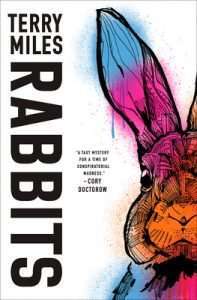 Rabbits is based on the world of long-form pseudo-documentary by Terry Miles originally done in podcast format. The novel is about a narrator known as K searching for information about the addictive underground game called Rabbits.
Rabbits is based on the world of long-form pseudo-documentary by Terry Miles originally done in podcast format. The novel is about a narrator known as K searching for information about the addictive underground game called Rabbits.
Rabbits, the game is very hush-hush. Players who play it do not speak of it and operate on the clandestine fringes of retro-tech and obscure culture. All research done on the game takes place in a shadow world of people in the know. Finding information and clues about Rabbits becomes as much a part of the game as the obvious goal of winning. K’s research leads them down winding paths and rabbit holes, searching for information that will help K win the game. Once the game is won, a new iteration will start.
Eventually, K becomes wholly addicted to the game. With the help of K’s friend, Chloe, they become entangled in the game’s world. Also, to complicate things, a reclusive billionaire gets involved in the plot who mysteriously ends up disappearing and eventually winning the game has possible world-ending repercussions. Everything has become a lot bigger than just a game.
Terry Miles’s writing feels very much like listening to a mystery podcast. I haven’t heard the original Rabbits podcast. However, it has a dedicated cult-like following. The problem that I ran into with Rabbits is positive and negative. Rabbits is a very intricate and entangled story. The characters question their reality, and the story’s narrator is unreliable. It can be challenging to follow along, and I found myself going back and rereading sections of the book, trying to keep track of some of the plot details. This is a positive for me as a reader. I love untangling webs of clues, and riddles. I find this kind of story very engaging, and I am a fan of unreliable narrators. No part of K’s journey is straightforward. I can understand how a story like Rabbits would be a bit much for some readers to enjoy. As it might not be everyone’s cup-of-tea you will know fairly quickly as the story progresses if this style of storytelling speaks to you as a reader.
I can see a story like Rabbits obtaining a cult-like following with the strength of his writing and world-building. Especially if Miles continues to write in this world and interconnects Rabbits to other books.
Read Rabbits by Terry Miles
The post REVIEW: Rabbits by Terry Miles appeared first on Grimdark Magazine.
March 17, 2022
An interview with Ciel Pierlot
The amazing queer stories currently coming out in the science fiction genre have really turned me into an avid reader in the genre from a somewhat reluctant one. And one of the books that has had the most impact on me as a reader is Bluebird by Ciel Pierlot. Thanks to Angry Robot, I’ve had the opportunity to have a chat with the debut author about Bluebird, writing and stories. And if this has whet your appetite, check out our review of Bluebird here.
 [GdM] Can you pitch Bluebird in one sentence for our readers?
[GdM] Can you pitch Bluebird in one sentence for our readers?
Former war criminal decides to become a rebel, does a lot of crime, and then has to save her twin sister with the power of aggressive optimism and guns.
[GdM] One of my favourite parts of Bluebird were the characters. Can you tell us a bit more about your process for them? And what comes first, the characters or the story?
With Bluebird, the characters came first. Rig, specifically, came first and then I thought “Oh yeah that’s a lesbian, lemmie get her a girlfriend”, so June came into existence. With Ginka, I thought it would be very funny to have a typical “Drop your weapons or this random civilian dies!” scene, only for the random civilian to kiss ass. With some things I’ve written, the story does come first and the characters grow from that. For me, I think it’s probably pretty random which comes first.
[GdM] Is there anything you had to cut from the drafts that you’re sad about not having in the final version?
Hm… nothing that I’m truly sad about. There’s a chapter where Rig tells Ginka a myth from her culture, and originally that scene was a lot longer and the myth a lot more detailed. I think it was objectively good to make that way shorter, but I liked the original myth a good deal.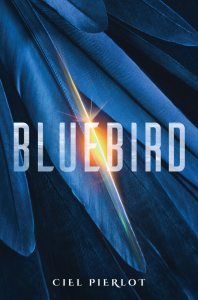
[GdM] What was the editing process with Angry Robot like? What were your favourite bits, and what were maybe some of the more challenging bits on the road to publication?
SO many edits. Both my agent and my editor pushed me into a lot of edits and I’m so grateful they did because each round made the book significantly better. For me, the most challenging part of the process was going through copy edits. I’m less than stellar at those in general (I’m sure there’s at least One Obligatory Typo that made it into the final version), and it was tough to go through those.
[GdM] How are you celebrating the release?
Due to the ongoing plague, there wasn’t really much of an option for any big launch party. Instead I’m having a couple close friends and family and such over for a fancy tea, complete with a Bluebird themed cake. Not to make people jealous or anything, but we’re making a lemon chiffon cake with blueberry jam cream for the filling, topped with vanilla buttercream and (hopefully) a winder blueberry glaze. Also a white chocolate bluebird on top. Me and my mom take desserts very seriously.
[GdM] Do you have a set writing routine?
Nope. I write pretty much constantly. In class but the teacher is pausing to put us in breakout rooms? Writing time. Working on essays? Tabbing out to write fiction. Playing video games? Writing while in queue.
[GdM] Are you working on anything new at the moment?
My next project is pseudo-victorian gothic vampires, featuring polyamory, excessive swordfights, a really big escape room, and oodles of The Aesthetic. Apart from that, I’m poking at the idea of a magical murder mystery. Very Agatha Christie ‘who dunnit’ style.
[GdM] What books or other media have filled your creative well recently?
I actually started playing this critically acclaimed mmo, Final Fantasy XIV, back in November and have spent literally all my free time since then injecting the entire game directly into my brain. I am attuned to the game on a molecular level. No thoughts in head, only FFXIV.
Read Bluebird by Ciel PierlotThe post An interview with Ciel Pierlot appeared first on Grimdark Magazine.
March 16, 2022
REVIEW: Shards of Earth by Adrian Tchaikovsky
Shortlisted for the British Science Fiction Best Novel award of 2022, Shards of Earth is the paragon of epic space operas. This first installment of the Final Architecture series is vividly imaginative with extraordinary alien species and hostile worlds. In Shards of Earth, Adrian Tchaikovsky elevates the “apocalyptic wasteland” to the cosmic stage.
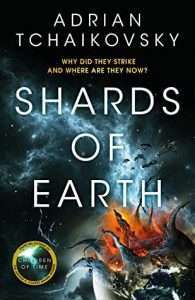 Shards of Earth features a formidable and galactic monstrosity, the Architects. A single Architect spans the size of Earth’s moon and is seemingly indestructible. Possessing the ability to shred whole planets apart, Architects travel across galaxies with the sole purpose of destroying inhabitable worlds. Their latest target is humanity. On the brink of being annihilated, humankind transformed a selective few into enhanced human weapons. In what appeared to be humanity’s final moments something impossible happened, the Architects simply vanished.
Shards of Earth features a formidable and galactic monstrosity, the Architects. A single Architect spans the size of Earth’s moon and is seemingly indestructible. Possessing the ability to shred whole planets apart, Architects travel across galaxies with the sole purpose of destroying inhabitable worlds. Their latest target is humanity. On the brink of being annihilated, humankind transformed a selective few into enhanced human weapons. In what appeared to be humanity’s final moments something impossible happened, the Architects simply vanished.
Adrian Tchaikovsky’s Shards of Earth takes place decades after humanity’s last confrontation with the Architects. Eighty years of war resulted in the destruction of Earth and billions of people dead. The remaining survivors are still scattered refugees, divided by extreme ideologies; their livelihoods susceptible to oppressive alien overlords and influential cults. They are tormented with the ever-plaguing question, when will the Architects return?
This novel is told from several perspectives, most notably from two distinct but enhanced human weapons who had survived the war. Idris Telemmier is an Intermediary or more often called “Ints.” Intermediaries are experimented-on humans with the ability to communicate with Architects. Their mutation also grants them an unprecedented and unmatched gift for space piloting. Myrmidon Solace is a Partheni, an engineered warrior woman. Together, these human weapons once saved humankind, but a growing contempt for all unnatural humans has left them alienated.
I greatly appreciated Tchaikovsky’s approach to these heroes. Neither Intermediaries or Partheni were killing machines or perfectly crafted superbeings. Most Intermediaries lose their minds using their abilities. Since Partheni are women engineered from a specific gene line, their harsher critics have erased their heroic deeds and relabeled them as “man-haters” and “programmed like machines.” Their appearance and disposition deemed too uncanny to be truly human. The perspectives from these scorned heroes offer an honest insight as an enhanced being.
“What’s the point of making better people, if they’re still sad and afraid and lonely?”
Shards of Earth is a challenging and most rewarding read. This doesn’t mean his novel has a slow start. While a good portion of fundamental history is introduced in the beginning, Tchaikovsky’s novel is action packed from start to finish. Once I understood humankind’s history with the Architects and the decades it took in building new colonies, I fell in love with Tchaikovsky’s world. His new depiction of space travel haunts me. His alien species are intricate and numerous. Shards of Earth offers the best of modern sci-fi.
Adrian Tchaikovsky is an award-winning science fiction and fantasy author. He has written a great number of novels including Ogres and Guns of Dawn. He specializes in complex themes and fantastical worldbuilding. Shards of Earth is a triumphant showcase of his creativity.
Read Shards of Earth by Adrian Tchaikovsky
The post REVIEW: Shards of Earth by Adrian Tchaikovsky appeared first on Grimdark Magazine.
An Interview with David Slayton
Last year on a book tour, I first came across David’s book, White Trash Warlock, and I was immediately struck by the honesty that Slayton wrote the lead protagonist, Adam Binder. I immediately knew that what I was reading was a cut above it’s contemporaries. Adam Binder is not a flashy character; he doesn’t swagger or have false bravado. He is a man who has been put into untenable situations and uses his heart, empathy, and sheer force of will to get out of them. I loved this about the character.
 Furthermore, the Adam Binder series is set in Guthrie, Oklahoma. A place that most people would not be able to find on a map, but Slayton describes it down to the grain of sand and when you are done reading the first book, you feel like you know Guthrie as well as Adam does. These qualities, excellent writing, and world-building, as well as two amazing books in the series thus far made me want to know Slayton better as a writer. David was kind enough to oblige me and let me pick his brain a bit about Adam Binder, writing, fandom, and the environment.
Furthermore, the Adam Binder series is set in Guthrie, Oklahoma. A place that most people would not be able to find on a map, but Slayton describes it down to the grain of sand and when you are done reading the first book, you feel like you know Guthrie as well as Adam does. These qualities, excellent writing, and world-building, as well as two amazing books in the series thus far made me want to know Slayton better as a writer. David was kind enough to oblige me and let me pick his brain a bit about Adam Binder, writing, fandom, and the environment.
[GdM] Firstly, can you tell us a little about yourself?
Absolutely! I’m originally from Guthrie, Oklahoma, just like my character Adam Binder. I grew up in a trailer in the woods near Lake Liberty, and that background really feeds into Adam’s novels. I love fantasy but could so rarely find books about people like me, high school drop outs with a rural background, etc. so now I live in Denver, Colorado and write the books I always wanted to read.
[GdM] You are a big gamer and specifically liked Hades from what I read. I hear that Hades has an excellent storytelling element to it. What is it about Hades that you liked?
I’m a huge student of Greek mythology and I loved that Hades includes deities like Thanatos and Nyx, who aren’t as well known. I even have a print of Sleep and His Half-Brother Death (Hypnos and Thanatos) by John William Waterhouse hanging in my bedroom.
Beyond the story and the incredible art style, I loved the gameplay in Hades, but a big deal for me is when a game can incorporate romance in a great way. Getting to romance Thanatos as Zagreus was a really nice touch.
Darren Korb’s voice acting for Zagreus was so perfect. Did you know he composed the music too? Eurydice’s song, Good Riddance, performed by Ashley Barrett haunts me.
[GdM] Are there any other games that you play?
I’m a big RPG fan. The Mass Effect trilogy, on PC where I can run a mod so male Shepherd can romance Kaiden throughout the entire series, is probably my most beloved series, but I can certainly sink a lot of time into games like Skyrim and Assassin’s Creed: Odyssey. You might see me on Destiny 2 from time to time. I love the look and lore of that game.
Skyrim is like an old friend. I’ll power it up, up run a few quests, then put it down for a while. There are still corners of that game I’m discovering all these years later.
My happiest and most productive writing days are the ones where I write for a bit, go game for a few hours when I get stuck, and keep switching back and forth all day.
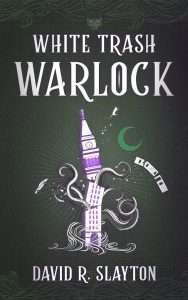 [GdM] You have a great article on your
website
about Star Trek Discovery and what Star Trek meant to you as a kid. Star Trek canon is moral, “
that humanity could grow beyond petty squabbles and conflicts over religion or resources to do something bigger. We could spread out, explore. We could forgo economics, hunger, and internal armed conflict.”
Do you think that Star Trek has lost its moral compass with its latest shows and movies, and how does it get it back?
[GdM] You have a great article on your
website
about Star Trek Discovery and what Star Trek meant to you as a kid. Star Trek canon is moral, “
that humanity could grow beyond petty squabbles and conflicts over religion or resources to do something bigger. We could spread out, explore. We could forgo economics, hunger, and internal armed conflict.”
Do you think that Star Trek has lost its moral compass with its latest shows and movies, and how does it get it back?
I think the recent shows deeply connect to Trek’s original ethos, especially when you see how Discovery explores the challenge of maintaining Starfleet’s ideals in situations like war or a far future where the Federation is greatly diminished. I’ll admit I only made it through the first of the recent movies because I didn’t feel like it embodied any of that. It felt more like space opera without the underlying moral complexity that has always made Star Trek special to me. I’m very excited for Strange New Worlds and I’m enjoying Picard (despite some character deaths that hit me hard) and the animated shows. Lower Decks does so many wonderful callbacks to Trek lore and has poked some fun at the action-based movies. Still, I’m grateful to those movies and Prodigy for bringing in new fans. Prodigy is beautiful and heart-filled, though geared for younger viewers. I’d love to see Farscape get an animated reboot of that quality. I especially love Discovery though. The acting, writing, effects—it’s just incredible.
[GdM] You said that you liked Star Wars for different reasons. How do Star Trek and Star Wars differ for you?
Trek is science fiction. It’s asking deeper questions. Star Wars is space opera and in many respects, fantasy. I love them both but for entirely different reasons, much like I love pizza and Greek food. I don’t think it’s fair to compare them and it’s okay to like both.
I go into watching Trek and come out feeling things and thinking. When I watch Star Wars I’m a little kid again, at the drive in theatre back in Guthrie, the Beacon, which still operates by the way, and full of wonder, especially when an X-Wing comes swooping onto the screen.
[GdM] Tell us a bit about the Adam Binder series and your latest book Trailer Park Trickster .
By the end of White Trash Warlock Adam uncovered a lot of secrets, things that had been affecting his world that he hadn’t even been aware of. In many ways that’s what the series is about: how secrets and past trauma, sometimes that of prior generations, can bleed over and keep affecting us even if we’re not aware of them.
In White Trash Warlock Adam had to leave Guthrie, go somewhere new, Denver, and reconnect with his estranged brother and mother. He was pretty angry. He still is really, but he’s starting to shed that and grow beyond it.
I flipped the script in Trailer Park Trickster. Adam has to rush back home, leaving his family behind. He also takes off without telling Vic, with whom he’s just starting to form a relationship, and that causes Vic to take off after Adam. Letting Vic take the second point of view in Trickster let me tell some very different stories in one book, including getting to write one of my favorite things: a road trip through the spirit realm. Though it has some dark moments, it was a lot of fun to write, and I hope readers can feel that on the page.
[GdM] I read, “Adam came later, and as I shaped his character, I quickly realized he was me. Well, okay, not me, but I poured a lot of myself into him. A lot of my pain and family history went into him” on your website. Was it difficult putting yourself into Adam, or did it organically flow as you wrote because you have similar personal experiences?
It was like opening a vein at times. So much of what Adam went through are things I went through, and dredging that up, processing it and dealing with it wasn’t easy. That said, the actual characterization was easy, because I’d lived it. I didn’t have to recreate the wheel to find those experiences and moments even if feeling it all again wasn’t easy.
[GdM] I love how White Trash Warlock is not formulaic like many urban fantasy stories out there. It is something different. What was the path like in the creation of Adam Binder as a character? Did he end up like you thought he would?
There’s this alchemical moment in writing, at least for me, when you set out to create something and it takes on a life of its own, becomes something so different than what you expected. My best characters are happy accidents. I felt a lot of that with Adam. While I poured so much of myself into him, he is himself. He’s cockier than I am but I think he’s kinder too. Sometimes he surprises me, when I’m trying to plan what comes next, but Adam is a good person. His choices always spring from that so when I get stuck I go back to that. Adam always does the right thing even when it’s hard or no one’s looking.
[GdM] Who does Adam eventually want to be?
I think he’s still figuring that out, but at his core, he wants to use whatever he has, no matter how little magic or privilege that might be, to help people. He’s a hero, doing the best he can for people with what resources he has.
Other powers in his world may have other plans. We’ll see how that evolves and turns out if the series continues, and I hope it does. I’d love to give readers the chance to meet Adam with a few more years on him and some fresh new tricks up his sleeve.
[GdM] You talk very candidly about mental health in the story—specifically Adam’s mental health and the fallout from being institutionalized in his teens. You wrote so eloquently and realistically about what he went through. Did you research mental health and institutions when creating Adam’s backstory?
I also have my own history that I don’t go into publicly, but I drew a lot from my own experience. While I have not been institutionalized, it’s been a part of my life, for people who are important to me. It’s not my story to tell so I’ll leave it at that.
My own mental health issues and history feed a lot into Adam’s, and I’m a big proponent of therapy and seeking help when you need it if it’s at all possible. It really does get better, and sometimes just have to hold on until better times come. That was where a lot of Adam’s experience with Liberty House came from, the times in my life when I felt trapped and isolated.
[GdM] Has anyone found any of the conspiracy theories and the easter eggs about Denver’s history you put in the story?
It’s very cool when someone connects the dots, but I think I might have hidden one or two things a little too deeply. I’ve gotten some great emails and comments in reviews. It’s really fun when someone finds them!
If we get to continue the series beyond book three I’ll try to weave in more of those things, because there is so much history hidden around us and a lot of it is important.
[GdM] Do you have an affinity for plants? One of the things I noticed when reading both White Trash Warlock and Trailer Park Trickster about the story is your descriptions of plants and their importance in the worldbuilding.
My maternal grandmother was big on plants and while I didn’t inherit her gift for gardening, I try my best.
Growing up in the country we had nearly a full acre committed to gardening and food. We had apple and pear trees that my grandfather took careful care of. I’ve replicated a little of that in my own yard. Plants were such a critical part of my childhood, and so they tend to show up a lot in my writing. My grandmother was particularly fond of irises and I’m so grateful to have some of her bulbs growing in my yard.
Follow me on Instagram to see all the flowers and things I’ve planted when they bloom in the spring!
[GdM] You write Adam’s family life as realistic and complicated. Often, family life is written tropey or an afterthought in urban fantasy. But in Adam’s case, it is integral to who the character is and where he came from. Before writing Adam, I read that you first envisioned and created Bobby, Adam’s brother. Did that play a part in how important the interpersonal dynamics were between Adam and his family?
I love fantasy, urban and epic, but I often can’t connect with the characters. Their families are killed off to incite conflict, etc. and in the end that leaves me feeling like they’re reduced. One thing I’m constantly looking for in characters is an emotional connection, and that makes a too powerful hero or someone without those roots too distant for me.
Bobby is the version of me that left Oklahoma, had to get out, and doesn’t feel like he could survive there. Because it’s fiction, I’ve taken that to an extreme place and he made some bad choices. That sets up a nice counter to Adam, who feels abandoned by his brother, which he was, and gives emphasis to the class conflict between them.
[GdM] You nailed how Oklahoma feels. I have been to Guthrie a few times and lived in Shawnee, Oklahoma. Was this story always set in Guthrie? Are there any other locations you considered?
It had to be Guthrie. It’s my home town, my roots, and it was a vital part of what I wanted to put into Adam. I love Guthrie. It’s a beautiful little town. I’m proud to be from there, even if I almost never felt like I belonged. I’ve been gone a long time but that red mud sticks to my bones and memories, so it was natural to make it part of Adam.
Book Three, Deadbeat Druid, has another road trip and I used a lot of great locations and history. As always I had to leave some out, but I snuck in as many as I could!
[GdM] One of the things I did not expect in the second book was the talk about climate change. Can you talk about how this all came about and why you chose this as a plot point?
It’s all around us. Here, in Denver, our snow came months late this year and you might have seen the news of how a terrible fire destroyed hundreds of homes, killing pets and displacing people on a massive scale – in winter. A snow storm came the next day, just a little too late.
I feel like denying the effect we’re having on our world is a terrible thing. We only have one, and it breaks my heart to see species go extinct or wide scale destruction of natural habitats. The elves in my books get that need to preserve the past from me. Once something is gone, it’s lost forever. One reason I write the Spirit Realm the way I do is that creatures long gone from our world still thrive there. It was a way of easing the pain of that loss.
And ultimately climate change is a class issue, which is a big part of Adam’s books. While we can all do a little bit through reducing our impact, recycling, and reusing the truth is that corporate interests are the heart of the problem and have to be addressed if we’re going to make a change. It’s easy to feel powerless in the face of that kind of money and the political power it buys, which makes it a natural way to relate to Adam’s position in the magical hierarchy.
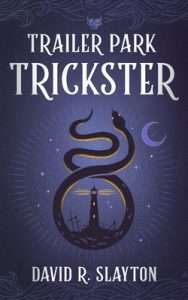 [GdM] Let’s talk about Vic for a moment. He seems very realistic and well researched. Did you study the Denver Police Department in the creation of him?
[GdM] Let’s talk about Vic for a moment. He seems very realistic and well researched. Did you study the Denver Police Department in the creation of him?
My father was a cop for a long time, and worked in public service most of his life. That gave me the chance to see both the good and the bad in law enforcement. I talked to cops and read quite a bit on the Denver force before writing. We’re having an important conversation about the role of police in our society right now and I’m trying to engage with that, as is Vic.
Vic is a rookie and he’s still sort of naïve to the system he’s working in, which is a theme I’m exploring more as he grows as a character. His relationship to his job and what that means to him will continue to evolve in book three.
[GdM] Vic also grows significantly as a person and starts to question everything about his life, spirituality, job, and sexuality. Will we see more of Vic’s growth in the next book? Can you speak a bit about what part of Vic’s life you explore in book 3?
Deadbeat Druid continues the split point of view between Adam and Vic. By the end of Trailer Park Trickster they’d each come to some realizations about themselves and how they feel about each other, but it was important to me that Vic be his own person, have his own journey—apart from Adam.
I don’t want Vic to be just the love interest. I don’t want to spoil too much but Vic’s understanding of himself, his past, and what he’s clinging to and what he needs to let go of is a big part of his story in book three. Like Adam, he’s growing and adapting to this magical world he’s found himself in.
[GdM] What is next for you? What are you working on?
I’ve got several things cooking which I can announce soon, but at the moment I’m working on an epic fantasy and a space opera. I like to mix it up. My poor agent. I’m always throwing something new at her!
If anyone wants a sneak peek when I can drop some news, sign up for my newsletter at www.davidrslayton.com or follow me on social media. I’m on the edge of my seat to get to tell everyone
Read David Slayton’s Work
The post An Interview with David Slayton appeared first on Grimdark Magazine.
March 15, 2022
REVIEW: Resident Evil: Welcome to Racoon City
Resident Evil is one of my all-time favorite video game franchises but it is also something that I can honestly say no one has ever experienced for their deep and meaningful plots. It’s not that the games don’t have interesting plots, it’s just that they’re deliberately cheesy and B-movie like.
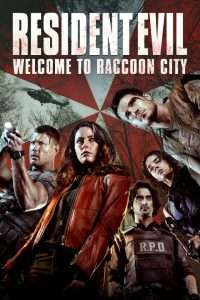 I say this as someone who proudly admits that he read the S.D. Perry novelizations of the games in the Nineties that is probably the absolute worst way to experience the franchise. The Umbrella Corporation is the stupidest corporation of all time in terms of making money and poor safety standards, even exceeding Aperture Science and Omni Consumer Products.
I say this as someone who proudly admits that he read the S.D. Perry novelizations of the games in the Nineties that is probably the absolute worst way to experience the franchise. The Umbrella Corporation is the stupidest corporation of all time in terms of making money and poor safety standards, even exceeding Aperture Science and Omni Consumer Products.
Nevertheless, there’s been people who have always wanted a more faithful adaptations of the games than the pre-existing Paul W.S. Anderson Resident Evil movies. Personally, I’ve always had a soft spot in my heart for them alongside the Underworld movies. I don’t ask much more from my films than the stunning lead kicking all sorts of monster butt. Yes, they’re terrible but they’re also fun and that is the spirit of the Resident Evil franchise. Which brings us to the story of Resident Evil: Welcome to Racoon City and the question of, “How faithful should a video game be?”
It’s not a perfect adaptation of the video games, far from it. Indeed, there will undoubtedly be some fans who are upset that Barry Burton is missing, there’s no Mr. X, and there are two Doctor Birkins working for the Umbrella Corporation (not just her dad) you sexist pigs! FYI, that was a joke. You never can tell on the internet these days. Either way, though, it is about a thousand times closer to the video games and is so full of Easter Eggs and references that I’m not sure it’s possible to stuff more into the film.
The premise of Resident Evil: Welcome to Racoon City is Claire Redfield (Kaya Scodelario) heading to Racoon City to visit her brother, Chris Redfield (Robbie Amell), when she discovers the town is overrun by zombies. Leon S. Kennedy (Avan Jogia) is in over his head, especially when Chief Irons (Donal Logue) decides to skip town in the middle of the crisis. We also get a flashback to the assault on the Spencer Mansion by Jill Valentine (Hannah John-Kamen) and Albert Wesker (Tom Hopper). Add in William Birkin (Neal McDonough) trying to escape with his family.
The recreation of Racoon City and the Spencer Mansion in Resident Evil: Welcome to Racoon City is fantastic with all of the actors doing a fine job with the material. Chief Irons is not quite the serial killing monster he is in the games but still pretty damn evil and enjoyable as a foil to Leon. He clearly knows SOMETHING is happening and doesn’t care about the people.
Wesker is way too empathetic and actually causes me to confuse him with Chris Redfield at times, especially given Tom Hopper’s chemistry with Hannah John Kamen. They seem to have combined his and Barry’s roles in the story to poor effect. Did this movie need David Harbour as Barry Burton? No, but it feels like it would have been the cherry on a perfect sundae.
Resident Evil: Welcome to Racoon City kind of wavers between subtler horror movie and conspiracy thriller, with a surprising lack of action. It’s just kind of funny because any gamer, who will be the movie’s primary audience, already knows all of the twists and turns. Also, there’s big enough changes (like Claire and Jill’s meeting plus the inclusion of Lisa Trevor) that will prevent a 100% faithful adaptation. It’s still about 80%, though, and I enjoyed it greatly. If you’re not a die-hard fan of Resident Evil, a lot of the references will go over your head and you’ll definitely benefit from having recently played Resident Evil 2’s Remake.
Watch Resident Evil: Welcome to Racoon CityThe post REVIEW: Resident Evil: Welcome to Racoon City appeared first on Grimdark Magazine.
March 13, 2022
An interview with Cory Burns
Responsible for the inception and writing of dark fantasy roleplaying game Red Giant: A Cursed World, Cory Burns is an immensely busy individual steeped in the creation of frightening worlds full of inhuman horrors and mind bending magic. It’s not an easy job, bringing something as all-consuming and immersive as a whole TTRPG setting to life, it’s more closely aligned to a vocation. A calling. One Cory has answered and risen to the challenge of, creating a game players and truly lose themselves in and tell stories of triumph and tragedy, heroism and horror.
I was incredibly fortunate to be given the opportunity to pick Cory’s brain on everything from how he managed to conceive Red Giant, his work process, his history and what his vision for the future holds. It was an excellent interview. Cory is an articulate and enlightening individual with a wealth of insight into gaming and the creative process, and I’m very excited to be able to share the experience.
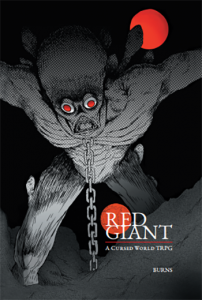 [GdM] Writers are often told to tell the story they want to read. With Red Giant, did you create the game you wanted to play? It definitely fills a particular niche, so where did it come from?
[GdM] Writers are often told to tell the story they want to read. With Red Giant, did you create the game you wanted to play? It definitely fills a particular niche, so where did it come from?
[CB] Red Giant: A Cursed World TTRPG is actually the second version of the game, which I think is a little-known fact among people who have bought or played the game. I started the original game as a hack of Knave to explore more OSR styles of play that were compatible with other materials. Once it was complete I found myself wishing I had dumped more originality into the game and spent more time fleshing out the additions to the system. After releasing our flagship game “Over Arms” I decided to revisit Red Giant and set-out to remake the game into its own dedicated system with a plethora of different mechanics, sub-systems, and an expanded, dedicated bestiary. I feel strongly that Red Giant is in a much better place than it was originally and I definitely enjoy the game more as a result.
[GdM] Red Giant focuses strongly on roleplaying, as opposed to rollplaying. Telling stories, not just hacking and slashing and collecting loot and experience. It feels ideal for quick, mission based sessions. But how do you feel it stands up to long form, multi-session chronicles?
[CB] Red Giant is definitely a solid system for one-shot gameplay but absolutely stands up to the test of time when running longer campaigns. The world of Red Giant is harsh and unforgiving and so your characters will be lucky to make it through a full campaign allowing players to explore different character builds throughout the campaign. We also included a leveling system in the core book to allow players to increase their characters strengths through milestone leveling to further strengthen their characters across each session. My advice when playing a long form campaign is to never get too attached to your characters and try to tell their story as best as you can during their time in play.
[GdM] Beyond the obvious inspirations mentioned in the book itself, what were some other things that informed the conception of Red Giant? What made you feel the TTRPG market was ripe for a game like it?
[CB] There are a lot of fantasy and grimdark games out there already, when starting out making Red Giant I didn’t know if it would do well due to this or flounder in a sea filled with these types of games and become forgotten, so far I am impressed with the results of the game. When creating Red Giant I knew I wanted several things: 1. a rules-light environment that players can use as a toolkit to tell their own stories 2. an original system instead of leaning on OSR 3. A lot of flexibility for character creation, and 4. a bleak world that is beyond saving. Naturally a lot of anime and games influenced this like Attack on Titan, Dark Souls, Demon Souls, and various others, but I feel like none of the source material leans into this world that is beyond repair so I drew a lot of inspiration from that concept alone.
[GdM] Adaptations are big business these days. So let’s play pretend. You get unlimited funds to convert Red Giant into any medium you want, tell any story you want to tell, what’s it going to be? Get in touch with an anime studio and create a full-length animated feature? Live action? A graphic novel? And what’s the story you want to tell?
[CB] That’s a fun question, I think naturally if I had unlimited funding I would choose them all, but if I had to pick one I would definitely love to see Red Giant translated into an anime or a live-action TV series simply to expand the medium and get viewers into tabletop roleplaying games. Also, who wouldn’t want to see this world in motion!? As for the story, I’d leave that up to the director / writers, the game is a toolkit at heart and I’d love to see what they brought to the table on the condition that they somehow fit the Thirteen Kings from the bestiary in somewhere.
[GdM] What’s in the future for Red Giant? Are there any sourcebooks and supplements in development right now, or ones that you’d like to do to expand on the world? You’ve created such a great sandbox to play in, the possibilities are damn near limitless.
[CB] Thanks for the kind words here, I really appreciate it. Right now there is another scenario I’m adapting that was written by a close friend and colleague that will be released for free. Beyond that I would really like to focus on sea travel and the different adventures that could take place there within the Red Giant universe, it might be a scenario or a supplement but no news on that just yet!
 [GdM] Something more fun. You’re obviously a fan of anime, seeing as you list things like Vampire Hunter D, Berserk, and Claymore as direct influences on Red Giant. So what’s your favorite anime? Series or movie. And beyond the three listed above, what are some other anime or movies you’d recommend people check out to inform their experience before playing?
[GdM] Something more fun. You’re obviously a fan of anime, seeing as you list things like Vampire Hunter D, Berserk, and Claymore as direct influences on Red Giant. So what’s your favorite anime? Series or movie. And beyond the three listed above, what are some other anime or movies you’d recommend people check out to inform their experience before playing?
[CB] My all-time favorite anime is FLCL (or Fooly Cooly), I’ve probably watched that at least a hundred times through, if you haven’t seen it and enjoy watching anime I am of the opinion that you’re totally doing yourself a disservice by not watching it. As far as other anime to watch for Red Giant inspiration goes I think I would have to suggest Afro Samurai for the outlandish fight scenes and enemies, Gungrave for the plot and characters, and finally you can never go wrong with the classic Vagabond.
[GdM] Something more personal. What got you into writing and developing roleplaying games? Safe to assume you’re a gamer, but what got you to take the plunge and start making games of your own?
[CB] It all started because I was tired of making video games due to how much work they are. When making a video game you have to focus on so many things like art, music, sound effects, programming, level design, voice acting, animation, etc., and it was becoming too taxing for a one-man team. After playing a few tabletop RPGs with friends during this lull, I became obsessed with trying out any game I could get my hands on or at least reading the rulebook for ideas. I was absolutely captivated over how manageable designing these games could be since you don’t have to focus on the same things required by a video game like voice acting, sfx, music, etc. Instead of programming the logic for a computer to handle for the player, you were basically writing logic for the GM to process and use as they liked and I found it more digestible and more interesting than what I had been doing for the past decade or so.
[GdM] Is there anything you’ve got going on you’d like to pump or promote? Whether Red Giant or Rookie Jet related, or anything else? What’s something you’re hyped about right now you want people to know about?
[CB] My friend over at Cave of Monsters (creator of Rider Konchu and Henshin) has a really cool game inspired by the Ultraman series called “3 Minutes” that I think is really rad and people should check out, Sam is a great person and really deserves all the attention he can get. As for Rookie Jet Studio, we have some more projects up our sleeves for the year and we are planning on launching a Patreon soon to help fund some other projects both original and related to our previous games like Red Giant and Over Arms. For now, just follow us on Twitter for all your Rookie Jet updates!
The post An interview with Cory Burns appeared first on Grimdark Magazine.
March 12, 2022
REVIEW: Hen Kai Pan by Eldo Yoshimizu
Hen Kai Pan (which translates to “One and All”) by Eldo Yoshimizu is a surreal, abstract experience that concerns itself largely with the philosophical nature of man’s existence and the question, “does man deserve the Earth?” Humanity, though, has very little to actually do with the story itself as it’s told throughout the pages of Hen Kai Pan. Instead, we witness a number of humanoid spirits as they observe the planet and sit in judgment of humanity itself, debating amongst each other what should be done and what man’s ultimate fate should be. The entities could be considered gods, but that term feels almost too simplistic for what they actually are. Hen Kai Pan’s cast of characters are seemingly humanoid representations of various facets of nature itself, their thoughts and motivations ultimately alien and beyond mortal comprehension.
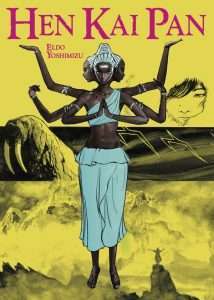 I assume this is why most of Hen Kai Pan revolves around the conflict of what could be considered a “lesser being,” one closer to humanity who works as a kind of intermediary of the nature spirits and serves as their living will. Ultimately, though, their fate—much like that of the reader—is simply to witness. Much of the drama and the action of Hen Kai Pan is a foregone conclusion. The fate of humanity, the fate of the planet, is set in stone. Is it because of the choices humanity has made? Was humanity always destined to walk the road it chose? Honestly, Hen Kai Pan presents a number of rather tough questions regarding the nature of existence and mankind’s role on the planet. And while at times it may seem bleak, much as the state of the world today oftentimes is, it offers a glimmer of hope somewhere off in the future as well—if not for humanity, then at least for the planet.
I assume this is why most of Hen Kai Pan revolves around the conflict of what could be considered a “lesser being,” one closer to humanity who works as a kind of intermediary of the nature spirits and serves as their living will. Ultimately, though, their fate—much like that of the reader—is simply to witness. Much of the drama and the action of Hen Kai Pan is a foregone conclusion. The fate of humanity, the fate of the planet, is set in stone. Is it because of the choices humanity has made? Was humanity always destined to walk the road it chose? Honestly, Hen Kai Pan presents a number of rather tough questions regarding the nature of existence and mankind’s role on the planet. And while at times it may seem bleak, much as the state of the world today oftentimes is, it offers a glimmer of hope somewhere off in the future as well—if not for humanity, then at least for the planet.
Hen Kai Pan is a thoughtful rumination that at times is a little bewildering, but throughout it is stunning and beautiful to look at. The art is phenomenal, Yoshimizu working in inks and washes to convey the story, at times creating staggeringly surreal imagery which left me simply staring at the pages. There are truly lovely moments strewn throughout the story, as well as gut-wrenching ones. When I was done, when I’d turned the final page on Hen Kai Pan, I found myself stuck wondering about life. Perhaps that’s the strength of the story, and the hope of its creator, that it will cause readers to think and wonder why. I’m giving Hen Kai Pan four stars for that reason, as it’s so rare to find a piece of work so thoughtful and affecting.
Read Hen Kai Pan by Endo YoshimuzuThe post REVIEW: Hen Kai Pan by Eldo Yoshimizu appeared first on Grimdark Magazine.
March 11, 2022
REVIEW: Ogres by Adrian Tchaikovsky
In his new novella, Ogres, Adrian Tchaikovsky explores the oppression of humans by savage ogres. Lacking the emotional capacity, size, and strength of their masters, humans are subjected to a life of fear and pain for generations. One human choice in the heat of the moment will lay the road toward the most important question of all: why?
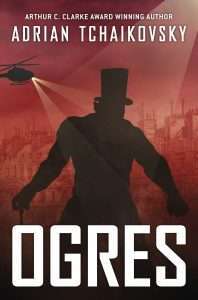 Aptly named, Ogres demonstrates a reimagined history of the world. For as long as anyone can remember, ogres have ruled over society and cultivated a natural order of things. Hailed as saviors of the world, these Landlords oversee and control the production, government, and every aspect of power, leaving the humans to be cowed and bent to their will. During a Landlord visit to one of their subjugated villages, things reach a boiling point between the human headman’s son, Torquell, and the Landlord’s son, Gerald, spiraling everyone down a path of secrets, truth, and justice.
Aptly named, Ogres demonstrates a reimagined history of the world. For as long as anyone can remember, ogres have ruled over society and cultivated a natural order of things. Hailed as saviors of the world, these Landlords oversee and control the production, government, and every aspect of power, leaving the humans to be cowed and bent to their will. During a Landlord visit to one of their subjugated villages, things reach a boiling point between the human headman’s son, Torquell, and the Landlord’s son, Gerald, spiraling everyone down a path of secrets, truth, and justice.
Ogres is classically Tchaikovsky with its interwoven complex themes, but also departs from his previous works into something more naturally dark and raw. From the story’s inception, the tone and atmosphere blatantly display the unforgiving nature of the world, specifically in regard to societal class and race. His execution with balancing the tone and atmosphere to interlay the themes is masterfully crafted and acts as one of the strengths of the novella. These concepts are threaded from beginning to end, filtering down into the side characters and seemingly insignificant actions.
Where some readers might need time to adjust to Ogres is with the second-person point-of-view. Used scarcely in the genre, the informal usage of “you” could invest the reader more closely to the story elements or act as a hindrance. This narrative choice adds to Tchaikovsky’s unique storytelling ability, casting the characters, setting, and thematic elements into a different light. Grimdark fans will appreciate his use of violence, difficult choices, and the bleak setting to advance his characters’ agency as things unfold in unexpected ways.
Although just over 100 pages, Ogres makes the most of its length. Filled with relatable ideas and quips of foreshadowing, the narrative wills a sense of foreboding that will compel you to keep turning the page. Tchaikovsky parallels his own story with his description choices, often times leaving the specifics to the imagination: “At no time do any of those characters step from the page to tell you what happened, but somehow the writer does.” However, the largest takeaway from the novella involves the quest for knowledge. While there might not be bad questions, there are right ones, especially when freedom is involved.
Thank you to Solaris for sending me an ARC of Ogres to review.
The post REVIEW: Ogres by Adrian Tchaikovsky appeared first on Grimdark Magazine.
March 10, 2022
REVIEW: Ruin by John Gwynne
The third instalment in the epic The Faithful and The Fallen series by John Gwynne is Ruin. This review will not contain spoilers for Ruin but I strongly suggest you do not read it if you are not up to date with the series. If you would like to know more about the preceding novels, Malice and Valour please head over to their reviews. Or just start this series because it is astounding.
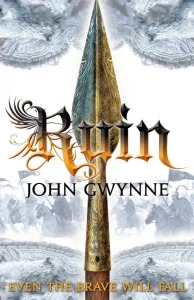 John Gwynne titled Ruin well. I am ruined after reading this novel. This is great grimdark writing and I am truly blown away by Gwynne’s skill in creating the Banished Lands, this ensemble of fantastic characters, and a plot that grabs the reader in a choke hold from the first page until the last over seven hundred pages later. I can think of few other series that are this consistently well written, and Ruin is only the penultimate offering. I think the final novel, Wrath, will be the crowning glory of The Faithful and The Fallen and I cannot wait to read it. As with the previous novels in the series, Ruin is a multiple point of view fantasy. It picks up straight after the ending of Valour with maybe a few hours plot wise between the conclusion of that and the introduction to Ruin. All but two of our perspectives in Ruin are ones that readers have already met so there is a familiarity to the viewpoints which makes the narrative move very quickly given the length of the novel. There is also a ‘Cast of Characters’ at the beginning of the book which serves as a handy reminder of who everyone is and what group they belong to. I personally did not care for either of the new characters, I think they may have been there purely for offering minor altered perspectives, but they may become of more importance in the last novel of the series.
John Gwynne titled Ruin well. I am ruined after reading this novel. This is great grimdark writing and I am truly blown away by Gwynne’s skill in creating the Banished Lands, this ensemble of fantastic characters, and a plot that grabs the reader in a choke hold from the first page until the last over seven hundred pages later. I can think of few other series that are this consistently well written, and Ruin is only the penultimate offering. I think the final novel, Wrath, will be the crowning glory of The Faithful and The Fallen and I cannot wait to read it. As with the previous novels in the series, Ruin is a multiple point of view fantasy. It picks up straight after the ending of Valour with maybe a few hours plot wise between the conclusion of that and the introduction to Ruin. All but two of our perspectives in Ruin are ones that readers have already met so there is a familiarity to the viewpoints which makes the narrative move very quickly given the length of the novel. There is also a ‘Cast of Characters’ at the beginning of the book which serves as a handy reminder of who everyone is and what group they belong to. I personally did not care for either of the new characters, I think they may have been there purely for offering minor altered perspectives, but they may become of more importance in the last novel of the series.
Something I really liked in Ruin however was that Gwynne will describe key moments from the perspectives of multiple characters. For example, if there is a significant battle this may be described by one of the characters fighting it, then the next chapter would be from the point of view of one of their allies watching it, and then a third might be from the perspective of the opponent. This makes it feel more immersive as a reader, but also very quick to read as there are many short and rapid chapters addressing an important event rather than one long one. As I have said before, Gwynne’s battle scenes are immense and when he uses this overlapped style to describe them they become a thing of wonder. There are points in Ruin where I genuinely became very anxious, and had goose bumps because of what I was reading.
I also loved that Gwynne’s characters are so morally varied. At this point in the series, the God War has begun, and there are quite clearly the ‘good’ side with Corban as the Bright Star and the ‘bad’ side with Nathair as the Black Sun, but within that divide there is a deluge of moral grey that makes the characters seem so real and with that they are unpredictable. There are however some indisputably evil characters in Ruin who have yet to get brutally eviscerated by a wolven, so I can but hope that this happens to them in Wrath. Though, this is grimdark, so maybe they won’t get their just deserts.
I felt fairly comfortable that I knew where Ruin was going as a novel. I grieved or cheered as the plot unfurled and felt content that I would ride out this great story. I was wrong. Gwynne blindsided me in the last fifty pages and the cliff hanger that he ended Ruin with is soul destroying. I am broken. Which is a sign of just how magnificent John Gwynne is as a writer.
The Faithful and The Fallen may not have a happy ending, but this literary journey is just so damn good that every fan of dark epic fantasy should read it. 5/5.
Read Ruin by John GwynneThe post REVIEW: Ruin by John Gwynne appeared first on Grimdark Magazine.
March 9, 2022
REVIEW: Gallant by V.E. Schwab
Gallant charmed me from the first page to the last. It is no secret that I adore V.E. Schwab’s books – just check out my review for The Invisible Life of Addie LaRue here. But it feels like Schwab is entering a phase in her career where her books are based on vibes and atmosphere, something that was true of Addie LaRue but is even more the case with her latest release, Gallant. Her books have always had a strong emphasis on character and setting over a fast-moving plot and I think that’s where her writing really shines. A book that is compelling enough to make me forget about plot and manages to keep tension throughout without much action? That’s a fantastic book for me.
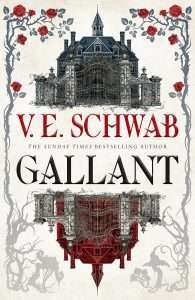 Gallant is a special book, one that is ostensibly published as a YA or crossover title, but in essence is an all-ages story. It has just as much to offer to an adult audience as it does to one reading up from their usual diet of middle grade. It is creepy, it is dark but it is also comforting, tender and utterly absorbent. It tells the story of Olivia Prior, a non-verbal teen, abandoned in a school as a baby after her mother’s passing. When she suddenly finds out that she does have a family after all, one who lives on a vast estate, she is drawn into a world of secrets and magic. As I mentioned, the story relies on character and atmosphere over plot and so this is a slow-paced exploration of identity, family and what you are willing to sacrifice those you care about.
Gallant is a special book, one that is ostensibly published as a YA or crossover title, but in essence is an all-ages story. It has just as much to offer to an adult audience as it does to one reading up from their usual diet of middle grade. It is creepy, it is dark but it is also comforting, tender and utterly absorbent. It tells the story of Olivia Prior, a non-verbal teen, abandoned in a school as a baby after her mother’s passing. When she suddenly finds out that she does have a family after all, one who lives on a vast estate, she is drawn into a world of secrets and magic. As I mentioned, the story relies on character and atmosphere over plot and so this is a slow-paced exploration of identity, family and what you are willing to sacrifice those you care about.
Schwab has managed to write another book that is a five star read without reservations. And this one is not merely a written story – there is a significant chunk of story told through gorgeous illustrations. This, and Olivia’s non-verbal nature make Gallant an interesting read in terms of communication. This means that much of the story relies on interior monologue and we get a lot of insight into the characters’ thoughts. Despite the added difficulties for the characters, Schwab manages to write them in ways where they do manage to communicate effectively and clearly – avoiding a trope that, to me, is extremely frustrating to read. It would be so easy to fall back into moments of communication lost in translation, but this is so much more satisfying.
All in all, Gallant is an excellent investment of your time and a continuation of everything that I’ve been loving about Schwab’s writing for years. But at the same time, it’s not really like anything I’ve read and that is a huge achievement. Five stars and a reread is already calling me.
Read Gallant by V.E. SchwabThe post REVIEW: Gallant by V.E. Schwab appeared first on Grimdark Magazine.



